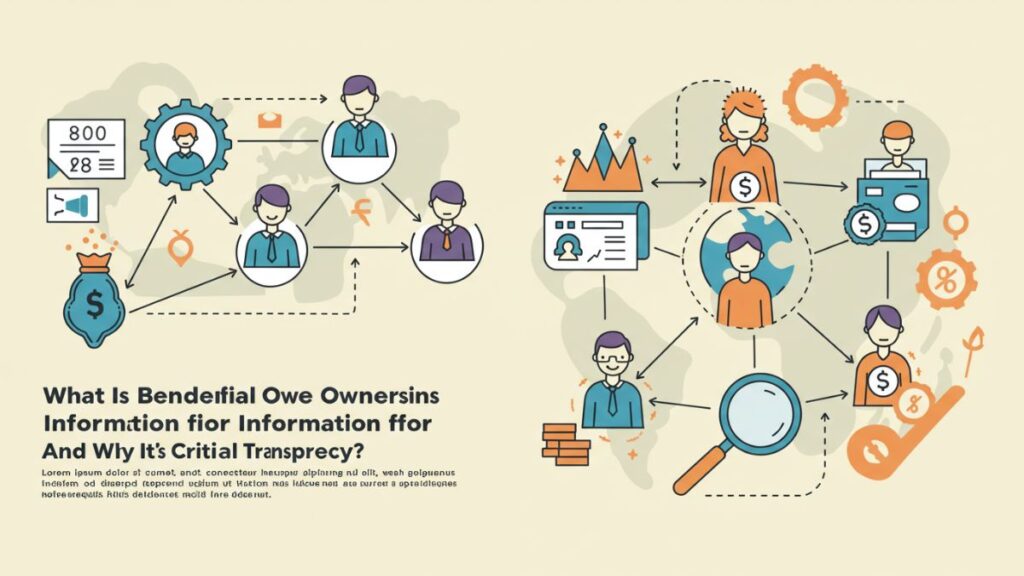In today’s global economy, transparency has become a central focus for governments, regulators, and financial institutions. One area where this push for clarity is significant is in understanding who owns and controls legal entities. We will explore how beneficial ownership information plays a vital role in exposing the individuals who ultimately benefit from companies, even if their names do not appear on official documents.
Companies are often formed under structures that hide or obscure the actual owners, which can be exploited for illegal purposes such as money laundering, tax evasion, or corruption. Identifying beneficial owners is a way to ensure that companies operate with integrity and are not being used to move illicit funds across borders. This kind of transparency gives regulators, law enforcement, and financial institutions the tools to assess risks and enforce compliance. It also helps build public trust by showing that no one is above accountability, no matter how complex their corporate structure may be.
Significance of beneficial ownership information
1. Understanding the Definition of Beneficial Ownership
Beneficial ownership refers to the real, living individuals who ultimately own or control a company, even if their names are not listed on official registration forms. This distinction is important because the legal owner of a company may be a nominee, proxy, or another corporate entity set up to conceal the actual person behind the business. In some cases, ownership can be layered through multiple companies in various jurisdictions, creating a complex and opaque structure that makes it difficult to trace the actual decision-makers. Laws and regulations in many countries now require businesses to disclose this information to ensure accountability and prevent misuse.
For instance, someone holding a significant percentage of shares, voting rights, or exercising control through other means, such as financial arrangements or agreements, would be considered a beneficial owner. These disclosures are significant in financial transactions and public contracting, where knowing who is behind a company helps prevent fraud and ensure compliance with anti-money laundering standards. By distinguishing between legal and beneficial ownership, authorities and organizations can better understand who benefits from a company’s operations and whether those individuals pose any risks or conflicts. Without this level of transparency, it becomes much easier for illicit actors to exploit corporate structures for personal gain while avoiding detection.
2. The Role of Beneficial Ownership in Combating Financial Crimes
One of the most important reasons for gathering and reporting beneficial ownership information is to help fight financial crimes. Criminals often use anonymous shell companies to hide assets, launder money, or finance illegal activities without revealing who is actually behind the transactions. These entities might look legitimate, but if their owners remain hidden, they can function as vehicles for moving funds without accountability. By requiring the disclosure of beneficial owners, governments and financial institutions gain a clearer picture of the people involved in a business. This helps them detect patterns that suggest criminal behavior or financial misconduct. When financial institutions know who they’re dealing with, they can assess whether a client presents a risk and take appropriate action to investigate further or decline a transaction.
Law enforcement agencies also rely on this information during investigations, as it often reveals links between businesses or individuals that would otherwise go unnoticed. The rise in international regulations surrounding beneficial ownership—such as those encouraged by the Financial Action Task Force (FATF) and the European Union’s anti-money laundering directives—reflects a global effort to close gaps in financial systems that have been exploited for years. As a result, businesses and their owners are now more accountable for their actions, and fewer opportunities exist for anonymous manipulation of financial systems.
3. Why Businesses and Governments Must Embrace Transparency
Beyond regulatory compliance and criminal prevention, there’s another reason why beneficial ownership matters—it builds public trust. When businesses disclose who is behind their operations, it demonstrates a commitment to openness and ethical conduct. This is especially important in sectors where contracts are awarded by public agencies or where companies are managing public funds. When ownership is hidden, it can create the perception of favoritism, fraud, or insider dealings, even if no wrongdoing has occurred. That’s why more governments are pushing for beneficial ownership registries that are either public or accessible to authorities and financial institutions.
These registries allow for a more level playing field by ensuring all companies, large or small, are held to the same accountability standards. For businesses, being transparent about ownership can also improve credibility with investors, customers, and partners. It shows that the company has nothing to hide and is willing to engage with stakeholders honestly. In a competitive market, that kind of transparency can become a strength rather than a burden. Moreover, it signals to other businesses and individuals that secrecy is no longer an acceptable standard. Transparency in ownership quickly becomes a global expectation, not just a legal requirement.
4. Reporting Requirements and the Path Toward Accountability
In recent years, reporting beneficial owner information has become a mandatory part of regulatory compliance in many countries. Laws such as the Corporate Transparency Act in the United States require certain businesses to submit detailed reports identifying the individuals who ultimately own or control the company.
These filings are typically made to a designated agency or financial authority and must be updated when ownership changes. For companies, this means creating internal processes to gather and maintain accurate information about shareholders, decision-makers, and those with significant influence.
Failing to report or submit inaccurate information can result in fines, legal consequences, or damage to a company’s reputation. However, the growing emphasis on these requirements also means more support and tools are available to help businesses meet their obligations. With transparent reporting frameworks, companies can avoid surprises and remain compliant with domestic and international standards.
Additionally, reporting serves as a reminder to organizations about the importance of transparency in their structure and operations. It encourages a shift in corporate culture toward openness and honesty, reducing the appeal of complex structures designed purely to conceal ownership or evade regulation.
Beneficial ownership information is influential in making businesses more transparent and accountable. Whether it’s used to prevent financial crimes, improve regulatory oversight, or build public trust, knowing who ultimately controls a company helps everyone make informed decisions—from regulators and investors to consumers and communities.







